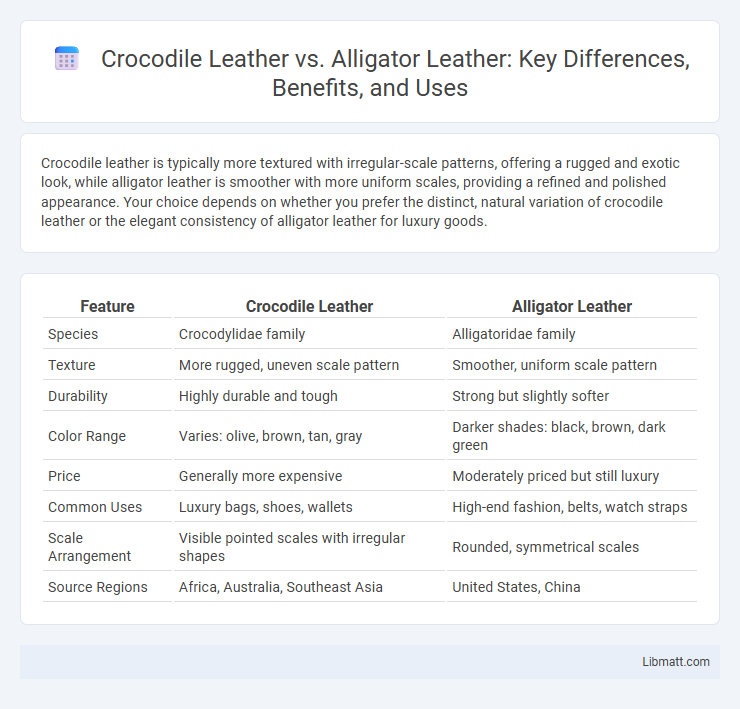Crocodile leather is typically more textured with irregular-scale patterns, offering a rugged and exotic look, while alligator leather is smoother with more uniform scales, providing a refined and polished appearance. Your choice depends on whether you prefer the distinct, natural variation of crocodile leather or the elegant consistency of alligator leather for luxury goods.
Table of Comparison
| Feature | Crocodile Leather | Alligator Leather |
|---|---|---|
| Species | Crocodylidae family | Alligatoridae family |
| Texture | More rugged, uneven scale pattern | Smoother, uniform scale pattern |
| Durability | Highly durable and tough | Strong but slightly softer |
| Color Range | Varies: olive, brown, tan, gray | Darker shades: black, brown, dark green |
| Price | Generally more expensive | Moderately priced but still luxury |
| Common Uses | Luxury bags, shoes, wallets | High-end fashion, belts, watch straps |
| Scale Arrangement | Visible pointed scales with irregular shapes | Rounded, symmetrical scales |
| Source Regions | Africa, Australia, Southeast Asia | United States, China |
Introduction to Exotic Leathers
Exotic leathers such as crocodile and alligator are prized for their unique texture, durability, and luxurious appeal, often used in high-end fashion and accessories. Crocodile leather features a more irregular scale pattern with narrower, diamond-shaped scales, while alligator leather is characterized by a uniform, symmetrical scale design and a softer, more pliable texture. Both types offer exceptional strength and water resistance, but alligator leather commands a higher price due to its rarity and smoother finish.
Understanding Crocodile Leather
Crocodile leather is known for its distinctive texture with irregular, more rugged scales compared to alligator leather, offering a unique aesthetic favored in luxury goods. Its durability and natural pattern variations make it highly sought after for crafting high-end accessories that combine strength with elegance. Understanding this material helps you appreciate the intricate qualities that differentiate it from alligator leather, especially in terms of texture and grain uniformity.
Characteristics of Alligator Leather
Alligator leather is known for its distinct, uniform scale pattern and natural sheen, which gives it a luxurious and high-end appearance. Its texture is smoother and more consistent than crocodile leather, making it highly desirable for premium products such as handbags, wallets, and watch straps. The leather is also more durable and flexible, offering superior strength while maintaining softness and comfort.
Physical Differences: Crocodile vs Alligator
Crocodile leather features a more irregular, varied scale pattern with smaller, thinner scales across the body, while alligator leather displays a more uniform, symmetrical scale arrangement with larger, thicker scales. The crocodile's belly leather shows a distinct, bumpy texture with a mix of oval and rectangular scales, contrasting with the alligator's smoother, more consistent rectangular belly scales. These physical differences impact leather durability and flexibility, making crocodile leather slightly tougher and alligator leather softer and more pliable.
Pattern and Texture Comparison
Crocodile leather features a more irregular pattern with scales varying in size and shape, giving it a rugged and natural appearance, while alligator leather boasts a more uniform and symmetrical scale pattern, characterized by larger rectangular scales known as "hornback." The texture of crocodile leather is generally coarser and more textured, whereas alligator leather offers a smoother, softer feel, prized for its luxurious finish in high-end fashion products. These distinct differences in pattern and texture influence the choice between crocodile and alligator leather for various luxury goods, reflecting preferences in durability and aesthetic appeal.
Durability and Strength
Crocodile leather is renowned for its exceptional durability due to its dense fiber structure, making it highly resistant to wear and tear. Alligator leather, while slightly softer and more supple, offers superior strength and flexibility, which enhances longevity and comfort in luxury products. Both types of leather maintain their durability over time, but crocodile leather is generally preferred for items requiring tougher endurance.
Luxury and Prestige
Crocodile leather commands higher luxury and prestige due to its rarity, distinctive scale pattern, and durability, making it a favorite for high-end designers and exclusive accessories. Alligator leather offers a smoother texture and more uniform scale, which adds to its elegance and desirability in luxury handbags and wallets. Your choice reflects a commitment to sophistication, with crocodile leather often perceived as more prestigious in the luxury market.
Price and Market Value
Crocodile leather typically commands a higher price than alligator leather due to its scarcity and the unique scale pattern that is highly sought after in luxury markets. The global market value for crocodile leather is driven by its use in exclusive fashion items and accessories, often making it a symbol of status and wealth. Alligator leather, while still premium, is generally more abundant and slightly less expensive, appealing to consumers seeking high-quality exotic leather at a relatively lower cost.
Ethical and Legal Considerations
Crocodile leather is often subject to stricter regulations under CITES (the Convention on International Trade in Endangered Species) compared to alligator leather, due to differences in species protection status. Alligator leather mainly comes from the American alligator, which has seen successful conservation efforts leading to more sustainable farming practices, reducing ethical concerns. When choosing between crocodile and alligator leather, your decision should consider the origin's legality and the impact on wildlife preservation.
Choosing the Best Leather for Your Needs
When choosing the best leather for your needs, crocodile leather offers a more durable and rugged texture with distinct, irregular scale patterns ideal for long-lasting accessories. Alligator leather provides a smoother, more uniform appearance with softer scales, often favored for luxury products such as wallets and handbags. Your decision should consider the balance between durability and aesthetic preference, as well as the type of item you want to craft.
Crocodile leather vs alligator leather Infographic

 libmatt.com
libmatt.com